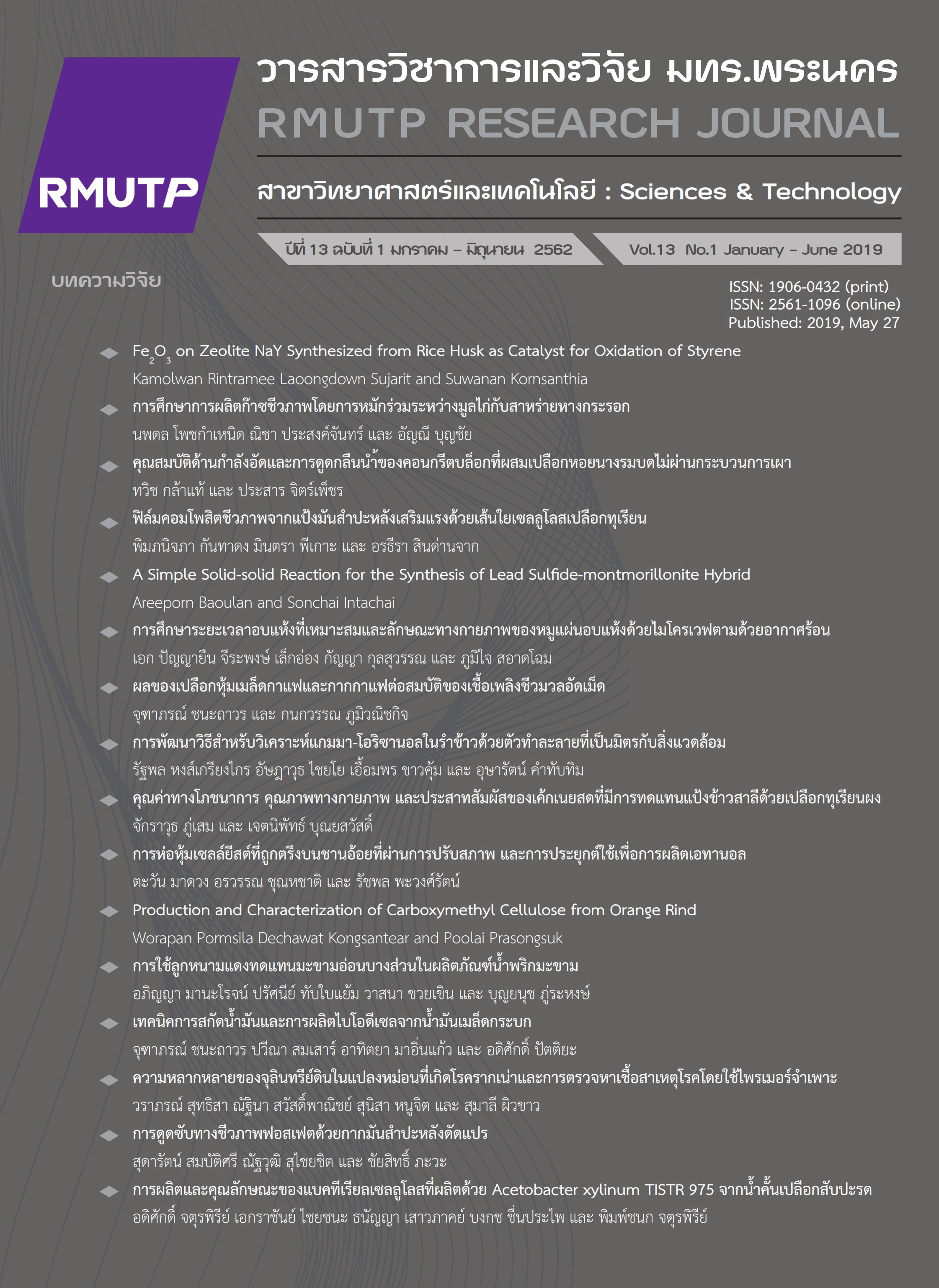The Study of Suitable Drying Time and Physical Characteristic of Pork Slices Dried Using Microwave Followed By Hot Air
Main Article Content
Abstract
The objectives of this research were to determine the suitable times of pork slices drying using microwave followed by hot air and to find specific energy consumption during drying. The physical characteristic (color and hardness) and the sensory test of dried pork slices were also investigated. Pork slices with the sizes of 50x50x1.3 and 50x50x2.2 millimeters were dried using the microwave at the powers of 160, 320, 480, 640 and 800 watts until the samples did not burn during drying. Then, the samples were dried using hot air at a temperature of 110oC until the moistures of the samples were lower than 20% dry basis. Based on the experimental results, it was found that the suitable times of the samples drying using microwave were 50-600 seconds which depended on the microwave powers and the pork thicknesses. In hot air drying period, drying times of the samples with thicknesses of 1.3 and 2.2 millimeters were 30 and 45 minutes, respectively. The microwave powers had no significant effect on the redness (a value) and yellowness (b value) of dried pork, the hardness of dried pork, and the specific energy consumption (P>0.05). The pork thicknesses had the significant effect on the lightness (L value) and yellowness (b value) of dried pork, the hardness of dried pork, and the specific energy consumption (P£0.05). Moreover, sensory scores of the dried pork obtained from this research were close to those obtained from the local market.the local market.
Article Details
References
[2] Office of Agricultural Economics. (2018, May 19). Thailand import and export statistics [Online]. Available: https://oldweb.oae.go.th/oae_report/export_import/export.php
[3] A. Arnarson. (2018, May 19). Pork 101: nutrition facts and health effects [Online]. Available: https://www.healthline.com/nutrition/foods/pork
[4] W. Kaensup. (2018, May 19). Microwave vacuum rotary drum dryer [Online]. Available: https://www.kmutt.ac.th/rippc/best1.htm
[5] S. Paengkanya, “Microwave-vacuum drying of Peeled longan,” M.Eng. thesis, Dept. Energy Tech., King Mongkut's University of Technology Thonburi, Bangkok, Thailand, 2010.
[6] G.A. Olatunde, G.G. Atungulu and D.L. Smith, “One-pass drying of rough rice with an industrial 915 MHz microwave dryer: quality and energy use consideration,” Biosystems Engineering, vol. 155, pp. 33-43, Mar. 2017.
[7] H. Pu, Z. Li, J. Hui and G.S.V. Raghavan, “Effect of relative humidity on microwave drying of carrot,” Journal of Food Engineering, vol. 190, pp. 167-175, Dec. 2016.
[8] G. Cuccurullo, L. Giordano, A. Metallo and L. Cinquanta, “Drying rate control in microwave assisted processing of sliced apples,” Biosystems Engineering, vol. 170, pp. 24-30, Jun. 2018.
[9] R.L. Monteiro, J.V. Link, G. Tribuzi, B.A.M. Carciofi and J.B. Laurindo, “Microwave vacuum drying and multi-flash drying of pumpkin slices,” Journal of Food Engineering, vol. 232, pp. 1-10, Sep. 2018.
[10] T. Basak and B.S. Rao, “Theoretical analysis on pulsed microwave heating of pork meat supported on ceramic plate,” Meat Science, vol. 86, no. 3, pp. 780-793, Nov. 2010.
[11] C. Jouquand, F.J. Tessier, J. Bernard, D. Marier and J.C. Laguerre, “Optimization of microwave cooking of beef burgundy in terms of nutritional and organoleptic properties,” LWT - Food Science and Technology, vol. 60, no. 1, pp. 271-276, Jan. 2015.
[12] A. Chinthammit, “Development of drying process of carrot and chicken by combination of air drying and microwave heating,” M.S. thesis, Dept. Food Science & Tech., Kasetsart University, Bangkok, Thailand, 2003.
[13] K. Rattanaphitakkul, “Influence of dehydration processes on quality changes and antioxidant activity of dried banana,” M.S. thesis, Dept. Food Science & Tech., Naresuan University, Phitsanulok, Thailand, 2007.
[14] S. Tirawanichakul, S. Lamaepae and Y. Tirawanichakul, “Combined infrared/microwave and hot air drying for jackfruit: kinetics, quality and sensory analysis,” Burapha Science Journal, vol. 17, no. 1, pp. 117-129, Jan. 2012.
[15] O. Buntawong, S. Pikasem and W. Intanun. (2018, May 19). Effect of processing methods on product quality of puffed job’s tears snack [Online]. Available: https://journal.rmutp.ac.th/wp-content/uploads/2014/08/Special-Food-Agriculture-Biotechnology-27.pdf
[16] T.Q. Le and W. Jittanit, “Optimization of operating process parameters for instant brown rice production with microwave-followed by convective hot air drying,” Journal of Stored Products Research, vol. 61, pp. 1–8, Mar. 2015.
[17] AOAC, Official Methods of Analysis of AOAC International. Virginia: Association of Official Analytical Chemists, 2012.
[18] P. Kongpoopha, U. Tapai and P. Sa-adchom, “Effect of drying temperatures on charcoal briquettes drying using a combined solar energy and far-Infrared radiation dryer, and a far-infrared radiation dryer,” RMUTP Research Journal, vol. 10, no. 1, pp. 77-93, Mar. 2016.
[19] K. Kanlaya, P. Sa-adchom and T. Swasdisevi, “Drying of ground fish slices using superheated steam combined with hot air,” RMUTP Research Journal, vol. 8, no. 1, pp. 51-63, Mar. 2014.
[20] P. Sa-adchom, T. Swasdisevi, T. Thomthong, P. Samuttharin and S. soponronnarit, “Drying of ground fish slices using superheated steam,” RMUTP Research Journal, vol. 7, no. 2, pp. 74-86, Mar. 2013.

